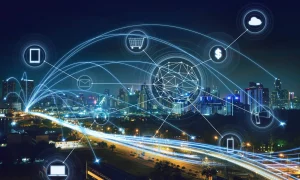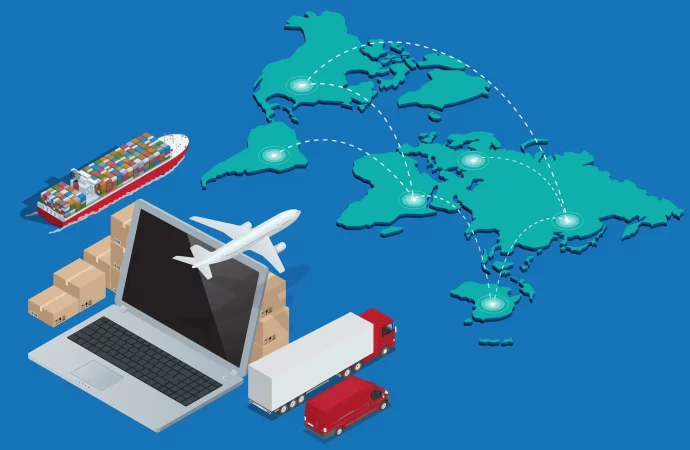In recent decades, technological advancements have revolutionized global trade, reshaping traditional practices and introducing new opportunities for efficiency, connectivity, and market access. From digital platforms facilitating cross-border transactions to advanced logistics solutions optimizing supply chains, technology plays a pivotal role in shaping the future of international commerce. This article explores the multifaceted impact of technology
In recent decades, technological advancements have revolutionized global trade, reshaping traditional practices and introducing new opportunities for efficiency, connectivity, and market access. From digital platforms facilitating cross-border transactions to advanced logistics solutions optimizing supply chains, technology plays a pivotal role in shaping the future of international commerce. This article explores the multifaceted impact of technology on global trade, highlighting key innovations, challenges, and regulatory considerations that define the contemporary global marketplace.
Technological Advancements Driving Global Trade

Image by : Yandex
Technological innovations have fundamentally altered the landscape of global trade across various domains:
-
Digitalization of Trade Processes
The adoption of digital technologies has streamlined trade processes, reducing paperwork, and enhancing transaction efficiency. Blockchain technology, for instance, offers immutable records of transactions, enhancing transparency and security in supply chains. Digital documentation and smart contracts automate processes such as customs clearance and payment settlements, accelerating trade transactions globally.
-
Logistics and Supply Chain Innovation
Advances in logistics technology have revolutionized supply chain management. IoT (Internet of Things) devices and sensors provide real-time monitoring of shipments, enabling proactive management of inventory and logistics operations. Autonomous vehicles and drones are transforming last-mile delivery, reducing costs, and improving delivery times. These innovations not only optimize operational efficiency but also enhance visibility and traceability throughout the supply chain.
-
E-commerce and Global Market Access
E-commerce platforms have democratized global trade by connecting businesses and consumers worldwide. Companies like Alibaba and Amazon facilitate seamless cross-border transactions, allowing small and medium-sized enterprises (SMEs) to access global markets with ease. Digital payment solutions further simplify international transactions, mitigating currency exchange complexities and reducing transaction costs.
Impact on Global Trade Dynamics
The integration of technology into global trade has profound implications for economic growth, market dynamics, and business competitiveness:
-
Increased Efficiency and Cost Reduction
Technology-driven efficiencies, such as faster processing times and reduced operational costs, enhance the competitiveness of businesses in the global marketplace. Automation and data-driven insights enable companies to optimize supply chain operations, minimize waste, and respond swiftly to market demands.
-
Expansion of Market Opportunities
Technology expands market access for businesses of all sizes, particularly SMEs. E-commerce platforms provide a global storefront, enabling SMEs to reach consumers in distant markets without the need for physical presence. Moreover, digital platforms enable diversification of supply chains, allowing companies to source materials and components globally, thereby enhancing resilience against geopolitical risks and market fluctuations.
-
Challenges and Considerations
Despite the transformative benefits, the adoption of technology in global trade presents challenges that require careful consideration:
- Digital Divide: Disparities in technological infrastructure and digital literacy hinder access to global markets for developing countries and marginalized communities.
- Cybersecurity Risks: The interconnected nature of digital trade exposes businesses to cybersecurity threats such as data breaches and ransomware attacks. Ensuring robust cybersecurity measures is crucial to safeguarding sensitive trade information and maintaining consumer trust.
Regulatory and Policy Implications
The regulatory landscape plays a critical role in shaping the evolution of technology-enabled global trade:
-
Trade Agreements and Digital Economy
International trade agreements increasingly address digital trade issues, including data privacy, intellectual property rights, and cross-border data flows. Harmonizing regulatory frameworks facilitates smoother trade operations and promotes innovation in digital trade practices.
- Economic Integration: Addressing regulatory harmonization to facilitate digital trade flows.
- Data Privacy and Protection: Ensuring compliance with international standards while promoting innovation.
-
Data Privacy and Protection
The proliferation of data in digital trade necessitates stringent data privacy regulations. Governments and regulatory bodies worldwide are implementing measures to safeguard consumer data and mitigate risks associated with unauthorized access and misuse of personal information.
- AI in Trade Analytics: Enhancing predictive capabilities and trade intelligence.
- 5G and Connectivity: Enabling real-time data exchange and IoT deployment in global supply chains.
Future Trends and Innovations
Looking ahead, several emerging trends are poised to further transform global trade:
-
AI in Trade Analytics
Artificial Intelligence (AI) and machine learning are revolutionizing trade analytics by enabling predictive insights and decision-making. AI-powered algorithms analyze vast datasets to forecast market trends, optimize inventory management, and enhance supply chain resilience.
-
5G and Connectivity

Image by : Yandex
The rollout of 5G technology promises to revolutionize connectivity in global trade. With ultra-fast internet speeds and low latency, 5G networks facilitate real-time data exchange, enabling seamless integration of IoT devices and enhancing operational efficiency across supply chains.
Competitive Analysis Table
| Company/Technology | Impact on Global Trade | Key Benefits | Challenges |
| Alibaba (Alibaba.com) | E-commerce platform connecting global buyers and sellers | Market access, cross-border transactions | Competition, regulatory compliance |
| Amazon (Amazon Web Services) | Cloud computing and logistics services | Scalability, supply chain optimization | Data security, regulatory complexities |
| Maersk (TradeLens) | Blockchain platform for supply chain transparency | Efficiency, security | Adoption, interoperability |
| UPS (UPS Global Trade) | Logistics and customs brokerage solutions | Global reach, supply chain visibility | Logistics infrastructure, costs |
| PayPal (Digital Payments) | Digital payment solutions for cross-border transactions | Convenience, currency conversion | Transaction fees, fraud prevention |
Strategic Analysis Table
| Strategy/Technology | Description | Benefits | Challenges |
| Blockchain in Supply Chain | Enhancing transparency and traceability in global supply chains through distributed ledger technology | Reduced fraud, improved compliance | Integration, scalability |
| AI in Trade Analytics | Using AI and machine learning to analyze trade data for predictive insights and decision-making | Enhanced forecasting, operational efficiency | Data privacy, algorithm bias |
| IoT in Logistics | Deploying IoT sensors for real-time tracking and monitoring of shipments and inventory | Improved visibility, proactive maintenance | Connectivity, data security |
| Regulatory Compliance | Ensuring adherence to international trade regulations and standards through digital solutions | Facilitated trade, reduced penalties | Complexity, legal frameworks |
Conclusion
Technology continues to redefine global trade, offering unprecedented opportunities for businesses to expand their reach, optimize operations, and innovate in a rapidly evolving marketplace. Embracing technological advancements while navigating regulatory complexities and cybersecurity challenges is essential for harnessing the full potential of digital trade. As global economies increasingly rely on digital connectivity, fostering collaboration and innovation will be key to driving sustainable growth and resilience in the global trade ecosystem.
One of the key challenges in tech regulation is keeping pace with the rapid pace of technological change. As new technologies emerge and evolve, regulators must be able to adapt quickly to address new threats and challenges. This requires a flexible and agile regulatory framework that can respond to changing circumstances while still providing a stable and predictable environment for businesses to operate in. Collaboration between governments, industry stakeholders, and civil society will be essential for ensuring that regulations are effective and responsive to the evolving tech landscape. By learning from the regulatory approaches of different countries and adapting best practices, policymakers can create a regulatory framework that is both effective and sustainable in the long term.
















